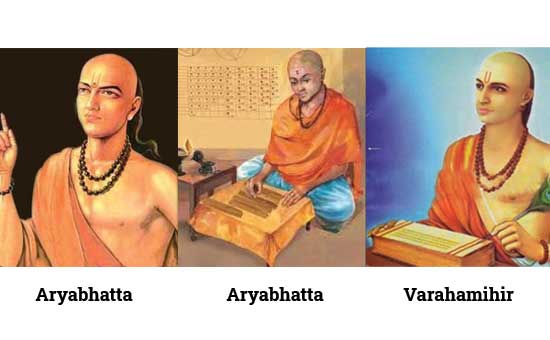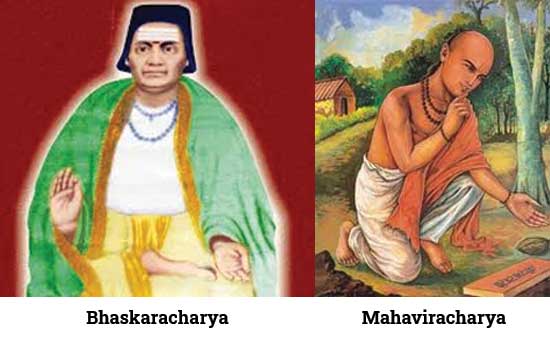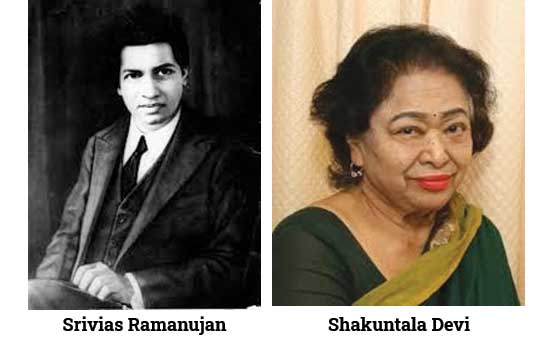- India
has a long-standing tradition of fundamental developments in Mathematics. A
brief account is presented here, confined to the work of some famous
mathematicians based on available references.
Studies
indicate that the first use of mathematics in India was during the Indus Valley
Civilisation. It was concerned mainly with weights and measures and a basic
knowledge of geometry.
There
were seven famous ancient mathematicians among whom Baudhyana is the best known. They formulated the four major Shulba Sutras or rules. One of the rules was later formulated by Pythagoras as a theorem.
In
addition to advanced geometry, they had simple ways of doing different
mathematical operations. For example, to multiply a two-digit number by 11,
say, 45 x 11, it can be calculated by writing down numbers 4 and 5 and
inserting between them their sum: 4 (4+5) 5 or 495.
Another interesting rule was for calculating the square of two-digit numbers ending with five. For example, to find the square of 35 you write down 25 and before it, the product of 3×4. The result is 1225.
Article is courtesy Bhavan’s Journal.

Classic Period
The
period between 400 CE and 1500 CE was the golden age of Indian Mathematics and
was called the Classic Period. There were outstanding mathematicians such as
Aryabhata, Varahamihira, Brahmagupta, Bhaskara I, Mahavira and Bhaskara II.
Aryabhata
Aryabhata
was born in 476 CE in Patna, Bihar. Some say he was born in Kerala. He is
famous for his work on lunar eclipse and solar eclipse, rotation of Earth on
its axis, reflection of light by moon, value of pi
correctly to 4 decimal places and calculating the circumference of Earth with
99.8 per cent accuracy. He wrote the famous Aryabhatiya when he was just 23
years old.
Varahamihira
He
was born in the 6th century CE in Ujjain. Varahamihira’s most notable works
were Panchasiddhantika and Brihat Samhita. He improved the accuracy
of the sine tables of Aryabhata. He was among the first mathematicians to
discover a version of what is now known as the Pascal’s
triangle and binomial coefficients. He invented the first known 4×4 magic square.
Brahmagupta
Brahmagupta
was born in 598 CE in Ujjain. His book Brahmasphutasiddhanta
is the first text that mentions zero as a number.
He gave many algebraic and arithmetic concepts and formulae. Brahmagupta
advocated observation and use of instruments. He dedicated an entire chapter to
yantras, or simple devices to observe the
sky. He explained negative numbers and their properties.

Bhaskara I
He
was born in Parbhani district, Maharashtra in the 7th century CE. He was the
first to write Hindu-Arabic numerals and zero with a circle. He gave a unique
and remarkable rational approximation of the sine
function in his commentary on Aryabhata’s work, Aryabhatiyabhashya, written in 629 CE. It is among the oldest
known prose works in Sanskrit on mathematics and astronomy. He also wrote Mahabhaskariya and Laghubhaskariya.
Mahavira
He
was a Jain Mathematician born in Gulbarga, Karnataka. His work was Ganithasarasangraha. The work comprises
more than 1,130 versified rules and examples divided in nine chapters on basic
operations, reductions of fractions, and problems involving a linear or
quadratic equation with one unknown. He devised a formula for the area and
perimeters of ellipses and found methods to calculate
the square and cube roots of a number.
Bhaskara II
Bhaskara
II was born in 1114 CE in Bijapur, Karnataka. He is known as the greatest
mathematician of medieval India. His work Siddhanta
Shiromani has laid the foundations for many theories
in arithmetic, algebra, mathematics of the planets, and spheres. He
conceived differential coefficient and differential calculus, way before Newton
and Leibniz. He also wrote a treatise named Karana
Kautuhala.
Modern Era
There
are outstanding contributions to mathematics, during the last century, by
scholars such as P C Mahalanobis, Narendra Karmarkar, D R Kaprekar, Harish
Chandra, C R Rao, C S Seshadri, Hemachandra and C P Ramanujan. Well-known women
mathematicians include T. A. Sarasvati Amma, Vasanti N. BhatNayak, Ushadevi
Bhosle, Vyjayanthi Chari, Nilanjana Datta, Shakuntala Devi, and many, many
more.

Srinivasa Ramanujan
Srinivasa
Ramanujan was born on December 22, 1887 in Tamil Nadu. He is one of the most
recognised Indian mathematicians although he had almost no formal training in
pure mathematics. He sent a set of 120 Theorems
to Prof. Hardy at Cambridge University and was invited to work there. He is
known for mathematical analysis, number theory, infinite series, and continued
fractions.
Shakuntala Devi
Shakuntala
Devi was known as the human computer. In
Dallas, USA, she calculated the cube root of 188138517 faster than a computer.
She also competed against a UNIVAC, then the world’s fastest computer to solve
the 23rd root of a 201-digit number and won. She had outstanding talent and set
world records.
Satyendra Nath Bose
Satyendra
Nath Bose was born on January 1, 1894 in Kolkata. He was a theoretical
physicist, known for his work on quantum mechanics
in the early 1920s, providing the foundation for Bose Einstein statistics and
the theory of the Bose-Einstein condensate. He was awarded the Padma Vibhushan
in 1954. The class of particles that obey Bose-Einstein Srinivasa Ramanujan
statistics are called Bosons.
To read article in PDF format click on PDF.
Also read
1.
The
man who knew infinity
2.
A
brief history of Indians Maths
3.
Talks
on Maths in Metrical form
4.
The
Story of Pythagoras
This
article was first published in the Bhavan’s Journal, 15 August 2020 issue. This
article is courtesy and copyright Bhavan’s Journal, Bharatiya Vidya Bhavan, Mumbai-400007. eSamskriti has
obtained permission from Bhavan’s Journal to share.